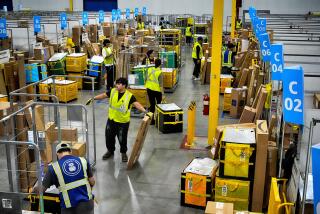Growth Rate for Economy Put at 3.9%
WASHINGTON — Boosted by a growing boom in manufacturing exports, the nation’s economy grew at a surging annual rate of 3.9% during the first three months of the year, the Commerce Department said Thursday.
The level was far above the 2.3% growth rate for the quarter estimated a month ago and also surpassed the expectations of financial markets.
Private economists, noting that exports surged to record levels in March while unemployment has continued to drop to levels unseen since the early 1970s, have abandoned all fears of recession any time soon. They now foresee the opposite threat: inflation, followed by higher interest rates, as the Federal Reserve cracks down on an economy in danger of overheating.
“Too much good news is what we are enjoying here,” said Frank McCormick, vice president and senior economist at the Bank of America in San Francisco. The Federal Reserve has been tightening the money supply since early April, “and we expect them to keep on tightening until early next year, at least,” he said.
Since mid-1987, the quarterly gross national product has surged at annual rates of 4.3%, 4.8% and now 3.9%, for an average of 4.3%. This is far above expectations for an economy well into the sixth year of an expansion, and especially so in the aftermath of the Oct. 19 crash in the stock market.
Economists said that as growth in the nation’s labor force slows with the decline in unemployment, the economy may grow no faster than 2.5% a year before irresistible inflationary pressures start to build.
“The bottom line is that the economy is growing too fast for stable inflation,” warned Bruce Steinberg of the Merrill Lynch brokerage firm in New York.
While calling the GNP surge “very large,” David Levine of Sanford C. Bernstein & Co., New York investment bankers, noted that the bellwether statistic that drives inflation was even stronger in the report.
That statistic, final demand, which represents domestic consumption, business investment, net exports and government purchases, increased at an annual rate of 4.5%, up from 2.6% growth in the earlier estimate.
“This is excellent from the point of view of growth, job creation and profits,” Levine said. “But it’s bad for inflation and interest rates.”
Allen Sinai, chief economist at the Boston Co. in New York, added: “This is a Fed-tightening report. With this kind of growth, we’re already above Fed targets for the year, which were in the range of 2% to 2 3/4%. We may have already locked in a growth rate as high as 3.5%, and it would be hard now to do worse than 3.2% or 3.3%.”
Those numbers dwarf the Reagan Administration’s forecast of 2.9% growth for 1988, which was once scoffed at as overly optimistic.
Because economic indicators for several weeks have shown the merchandise export boom, a surge in hiring and other factors, Thursday’s boom-time report did not have a great impact on Wall Street. Share prices churned in a narrow range. The Dow Jones industrial average was up a modest 5.38 points at the close.
By some measures in Thursday’s report, the inflation problem seemed tame in the three-month period ending in March. The measure in the GNP report that tracks inflation throughout the economy was revised downward to an annual rate of 1.7% from the 2.4% estimated a month ago.
But economists quickly pointed out that the measure is misleading in that it does not account for the cost of imports. Despite the recent improvement in the U.S. trade balance, the trade deficit in goods and services during the quarter was running at an annual rate of $109.4 billion.
The GNP index that accounts for all prices increased at an annual rate of 3.7% for the quarter, about the same as the 3.6% rate originally estimated. In recent months the price indexes for wholesale and retail prices have been increasing at annual rates between 4.5% and just over 5%, so higher prices seem inevitable.
The new report estimated that the economy during the quarter grew at an annual rate of $37.2 billion, contrasted with the earlier estimate of $15.4 billion. The GNP annual level for the quarter was $3.92 trillion in inflation-adjusted 1982 dollars and $4.67 trillion in current dollars.
More to Read
Inside the business of entertainment
The Wide Shot brings you news, analysis and insights on everything from streaming wars to production — and what it all means for the future.
You may occasionally receive promotional content from the Los Angeles Times.










